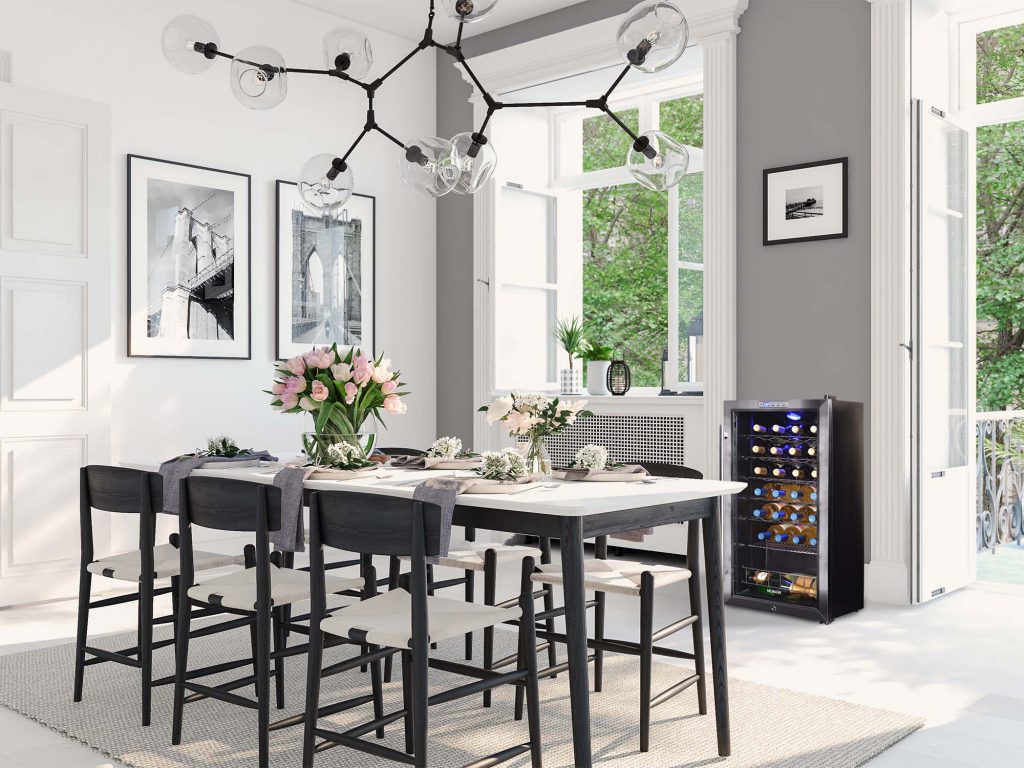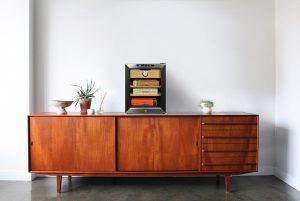What Is Thermoelectric Cooling — and Is It Right for You?
Thermoelectric coolers are making a splash in the market, promising to revolutionize that way you keep things cold, whether it's food, wine, beer or cigars. But if you're not a scientist — and if you shudder at memories of high school physics class — you may never have heard of this technology before. Is it really all that different from your good old kitchen refrigerator?
Yes. Thermoelectric cooling is a whole different ballgame when it comes to how it works. To know if it's right for you, it first helps to understand how both a standard compressor refrigeration system works and how thermoelectric ones change the game. One you know how they operate, it's easier to make an informed decision about which system is best for your needs.
How Compressor Coolers Work

You almost certainly have been using compressors all your life, whether you realize it or not. Compressors are the heroes of your household refrigerator, your dorm room mini fridge and every air conditioner you've ever turned on. A compressor works thanks to a special chemical refrigerant. This substance is able to turn from a liquid to a gas at fairly low temperatures (unlike, say, water, which has to reach the boiling point of 212 degree Fahrenheit to turn to a gas). When it expands into a gas, the refrigerant is able to absorb heat — the everyday magic that makes it possible to cool your food or your feet.
To visualize how this works, it's helpful to think about a window unit. Inside the air conditioner, the refrigerant travels in a closed loop that runs between the part inside the house and the part that hangs out the window. Inside the house, the refrigerant expands to a gas and absorbs excess heat from your room. As the refrigerant flows through the system, it carries the excess heat outside the home, where it can dissipate into the air.
 Whether they're attached to air conditioners or to your refrigerator, compressors work the same way to
keep things cool. When attached to a thermostat, compressors cycle on and off to keep temperatures within your
desired range.To keep the refrigerator running, the refrigerant needs to turn back into a liquid again. That's what
the compressor is for. It applies pressure to the refrigerant so it turns back into a liquid, and that process
allows all the heat the refrigerant had been carrying to be released into the air outside. Now that the refrigerant
is a cold liquid again, it's ready to head back inside to pick up more heat and continue cooling your room.
Whether they're attached to air conditioners or to your refrigerator, compressors work the same way to
keep things cool. When attached to a thermostat, compressors cycle on and off to keep temperatures within your
desired range.To keep the refrigerator running, the refrigerant needs to turn back into a liquid again. That's what
the compressor is for. It applies pressure to the refrigerant so it turns back into a liquid, and that process
allows all the heat the refrigerant had been carrying to be released into the air outside. Now that the refrigerant
is a cold liquid again, it's ready to head back inside to pick up more heat and continue cooling your room.
How Thermoelectric Coolers Work

As their name suggests, thermoelectric cooling systems rely on electricity for cooling. If you're thinking that electricity is only good for making heat (as it does when it flows through a light bulb or the heating element of a hair dryer), you've never heard of the Peltier effect.
The Peltier effect describes what happens when an electric current flows through two different types of conductors (for example, different types of metal like copper, zinc or bismuth telluride). When DC voltage is applied and direct current runs from one conductor to the other, there's a change in temperature where the two conductors join. If you run electricity from a bismuth wire to a copper wire, the temperature will drop at the junction where the wires meet. When you take this small thermoelectric effect and multiply it, you can create a cooling effect strong enough to keep electronic components in a computer cool — or chill the inside of a wine fridge.
This is typically done by creating many such junctions between two ceramic plates. When electricity runs through the whole thing, one plate is the "cool side" while the other is the "hot side." The cold side goes inside an ice-free cooler or wine refrigerator, while the hot side is connected to a heat sink, where metal fins help dissipate excess heat on the outside of the appliance.
Thermoelectric cooling (TEC) is also known as solid-state cooling, because there is no liquid refrigerant running through the machine. Instead, solid metal is used to transfer thermal energy.
The Benefits of Thermoelectric Cooling
In general, Peltier coolers work best in small spaces, particularly for electronic devices where there simply isn't enough space to put a compressor-based cooler. In a small size cooler, these systems are also quite efficient and may use less electricity than a compressor-based unit of the same size. Thermoelectric cooling also allows for very fine temperature control, to within 0.1 degree under certain conditions.
Solid state cooling units are also have no moving parts, so they are far less likely to break than a traditional compressor, which requires several fans and lengthy coils through which refrigerant must pass. The refrigerant itself is also problematic from an environmental standpoint: Chlorofluorocarbons (CFCs) and hydrochlorofluorocarbons (HCFCs) are known to damage the ozone layer if they leak from a faulty machine. Peltier devices, on the other hand, are no more harmful to the environment than a light bulb or basic fan you plug into an electrical outlet.
Finally, thermoelectric cooling is silent. Unlike a compressor, which vibrates when running and can be quite loud when it cycles on, the simple electric current required to run a TEC makes no sound at all, unless a fan is present to improve air circulation.
The Drawbacks of Thermoelectric Cooling
 Thermoelectric cooling units quickly become costly when used in large spaces. This is because you
need to add more ceramic plates to cover a larger area, and this will require higher input voltage to operate. The
more ceramic plates you have, the more electricity you'll need to use to run the machine, whereas a slightly larger
compressor doesn't use that much more electricity than a smaller one.Thermoelectric cooling is entirely dependent on
the ambient temperature for its ability to cool. Unlike a compressor system, which can maintain sub-freezing
temperatures in certain applications, a thermoelectric device can only bring down the temperature to a certain point
below room temperature. That means that if it's 65 degrees outside, and your TEC can bring down temperatures by 30
degrees, you can achieve a low temperature of 35 degrees. But when summer rolls around and the mercury rises, your
cooling capacity rises with it. On a 95-degree day, the cooler will only be able to hover around 65 degrees. This
may not be a problem indoors if you have central heating and air conditioning to limit extremes, but the temperature
difference can be a big deal in RVs or
camping applications. While thermoelectric cooling does offer fine temperature control, it's crucial to
understand that this is only within the range allowed by the outside temperature on any given day.
Thermoelectric cooling units quickly become costly when used in large spaces. This is because you
need to add more ceramic plates to cover a larger area, and this will require higher input voltage to operate. The
more ceramic plates you have, the more electricity you'll need to use to run the machine, whereas a slightly larger
compressor doesn't use that much more electricity than a smaller one.Thermoelectric cooling is entirely dependent on
the ambient temperature for its ability to cool. Unlike a compressor system, which can maintain sub-freezing
temperatures in certain applications, a thermoelectric device can only bring down the temperature to a certain point
below room temperature. That means that if it's 65 degrees outside, and your TEC can bring down temperatures by 30
degrees, you can achieve a low temperature of 35 degrees. But when summer rolls around and the mercury rises, your
cooling capacity rises with it. On a 95-degree day, the cooler will only be able to hover around 65 degrees. This
may not be a problem indoors if you have central heating and air conditioning to limit extremes, but the temperature
difference can be a big deal in RVs or
camping applications. While thermoelectric cooling does offer fine temperature control, it's crucial to
understand that this is only within the range allowed by the outside temperature on any given day.
Thermoelectric coolers also don't dehumidify the air around them. The ceramic plates simply transfer heat away from one area and into another, leaving the moisture content of the air intact. This is very different from compressor cooling, in which cold evaporators on the inside of the machine lower the dew point of the air and cause moisture to condense. These water droplets are carried outside and left to drip away in a compressor air conditioner, effectively lowering the moisture content of the air in your home. It should be noted that dehumidifying may or may not be a virtue depending on the application; for example, cigar humidors should stay quite moist as they cool, while a refrigerator for food should be dry to help keep rot at bay.
Is Thermoelectric Cooling Right for Me?

Most people don't build their own electronics, so thermoelectric cooling typically comes into play in small refrigerators or portable coolers for food and drink. So which is better when it comes to choosing a dedicated wine fridge or beverage fridge?
Choose a thermostatic cooler if ...
- ✓ You're very concerned about the environment
- ✓ You plan to keep it in a room with steady temperatures year round
- ✓ You are aging wine and wish to reduce vibrations that can stir up sediment
- ✓ You want exact control over the interior temperature
Choose a compressor cooler if ...
- ✓ You live in a climate with temperature extremes
- ✓ You want to be able to chill carbonated beverages to be extra-cold
- ✓ You aren't bothered by the sound of your regular refrigerator
- ✓ You need an extra-large storage capacity
 Thermoelectric cooling is a fascinating technology, and it definitely has its place when it comes
to wine coolers and humidors. Be sure to carefully compare your options as you shop and keep in mind the features
you personally find most important to select the perfect appliance for your home.One application where a
thermoelectric cooler is always a good choice? A high-performance cigar humidor. This is because
the Peltier effect doesn't have any influence over the humidity levels in your humidor, making it much easier to
keep humidity levels where you like them — without having to constantly add moisture to keep up with a compressor's
dehumidification. If you live in a cold climate, a thermoelectric cooler can also be run in reverse, which will
allow it to operate as a heater to maintain the perfect temperatures for your cigars all year round.
Thermoelectric cooling is a fascinating technology, and it definitely has its place when it comes
to wine coolers and humidors. Be sure to carefully compare your options as you shop and keep in mind the features
you personally find most important to select the perfect appliance for your home.One application where a
thermoelectric cooler is always a good choice? A high-performance cigar humidor. This is because
the Peltier effect doesn't have any influence over the humidity levels in your humidor, making it much easier to
keep humidity levels where you like them — without having to constantly add moisture to keep up with a compressor's
dehumidification. If you live in a cold climate, a thermoelectric cooler can also be run in reverse, which will
allow it to operate as a heater to maintain the perfect temperatures for your cigars all year round.
LEARN MORE:
NewAir Wine Coolers
- Precision controls keep wine at the perfect temperature
- Insulated doors protect and preserve wine
- Dual chill zones for perfect red and white wine storage



0 comments